Hey guys,
Just looking for some input/criticism on this project before I send these drawings out for cutting. I have a company that is going to cut these pieces out for me on a CNC Router out of Baltic Birch and ship them out to me, so I want to make sure I am not missing anything before I pull the trigger.
First off, one of my main concerns are the holes I’ve incorporated for glue up. I am intending on using 3/8” threaded rod during the glue up process and am going to drop each piece through the rod and use nuts and washers to crank the pieces together. I have never done a project like this before and am not 100% sure if there any problems that may arise from this that I have not thought of yet. So far my only concern is whether or not I should leave the threaded rod in place permanently or remove it. I am a little afraid of it causing problems acoustically down the road.
Secondly I am not sure if there are any limitations to the CNC that these drawings may interfere with. For instance, I was told by the shop that they will likely use a 3/8” bit for the CNC to do the cutting, so I therefore changed the threaded rod holes to 3/8” to hopefully save a bit of time and money and make things as seamless as possible.
Take a look and let me know what you guys think of the project overall. I am very excited to get started on it. It has come a very long way over the past year or so.
Just looking for some input/criticism on this project before I send these drawings out for cutting. I have a company that is going to cut these pieces out for me on a CNC Router out of Baltic Birch and ship them out to me, so I want to make sure I am not missing anything before I pull the trigger.
First off, one of my main concerns are the holes I’ve incorporated for glue up. I am intending on using 3/8” threaded rod during the glue up process and am going to drop each piece through the rod and use nuts and washers to crank the pieces together. I have never done a project like this before and am not 100% sure if there any problems that may arise from this that I have not thought of yet. So far my only concern is whether or not I should leave the threaded rod in place permanently or remove it. I am a little afraid of it causing problems acoustically down the road.
Secondly I am not sure if there are any limitations to the CNC that these drawings may interfere with. For instance, I was told by the shop that they will likely use a 3/8” bit for the CNC to do the cutting, so I therefore changed the threaded rod holes to 3/8” to hopefully save a bit of time and money and make things as seamless as possible.
Take a look and let me know what you guys think of the project overall. I am very excited to get started on it. It has come a very long way over the past year or so.
Attachments
-
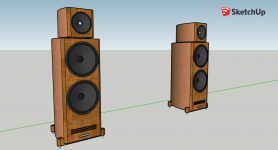 KEF Q350 - Round Edge Cuts1.png265.4 KB · Views: 261
KEF Q350 - Round Edge Cuts1.png265.4 KB · Views: 261 -
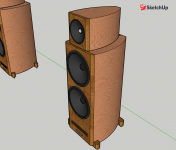 KEF Q350 - Round Edge Cuts7.png418 KB · Views: 250
KEF Q350 - Round Edge Cuts7.png418 KB · Views: 250 -
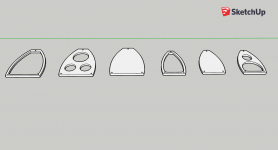 KEF Q350 - Round Edge Cuts2.png34.2 KB · Views: 256
KEF Q350 - Round Edge Cuts2.png34.2 KB · Views: 256 -
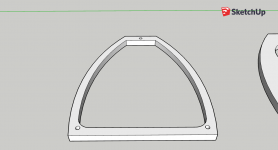 KEF Q350 - Round Edge Cuts3.png39.4 KB · Views: 267
KEF Q350 - Round Edge Cuts3.png39.4 KB · Views: 267 -
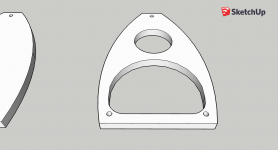 KEF Q350 - Round Edge Cuts4.png42.8 KB · Views: 257
KEF Q350 - Round Edge Cuts4.png42.8 KB · Views: 257 -
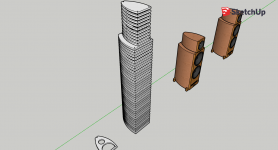 KEF Q350 - Round Edge Cuts5.png197 KB · Views: 113
KEF Q350 - Round Edge Cuts5.png197 KB · Views: 113
i am no big fan of translam but there is lots of experience here (& the problems experienced). I do expect you need to make the walls about twice as thick as if you used the material in the orientation is was designed to be used in. And putting a brace in a slice does little good. You need to drop a brace in that is perpendicualr to the slices and will actually brace every slice.
dave
dave
Thanks Dave,
The side walls are 3/4" which is the same thickness as the material. A since I am using it horizontally with the grain instead of on the flat AND it is curved I thought it would three times as strong/stable as using 3/4" baltic on the flat. The front wall is also 3/4", but is getting a solid piece of 3/4" Walnut over the top.
I don't see what you mean about the bracing. Because the brace slices will be glued top and bottom to their neighbor braces they should do the job, no? What do you mean about 'dropping' a piece in?
The side walls are 3/4" which is the same thickness as the material. A since I am using it horizontally with the grain instead of on the flat AND it is curved I thought it would three times as strong/stable as using 3/4" baltic on the flat. The front wall is also 3/4", but is getting a solid piece of 3/4" Walnut over the top.
I don't see what you mean about the bracing. Because the brace slices will be glued top and bottom to their neighbor braces they should do the job, no? What do you mean about 'dropping' a piece in?
I’d suggest that you will have to double that thickness. The way plywood is constructed it works better when used in the orientation designed for. As soon as you rotate the material and use it as in a translam, you throw away many of plywoods assets.
But since you are doing translam you should also consider adding a “textured" interanl surface, often done with the intent of reducing standing waves, rarely does the texture have sufficient depth to make any difference, but it will make the potential resonances of the box more spreadout with each potential resonance much harder to excite.
Glue only is not sufficient for the brace to do its work (the braces become much less effective, , and further, breaks the guideline that the aspect ratio of each subpanel should be higher than the panel’s before the brace.
The brace should be a separate piece that runs perpendicular to the slices and braces ALL the slices together. As well as doing a much better job as a brace, it also will stabalize all the slices and, in addition to the downs/threaded rod keep the slices all lined up. The extra effort in doing the brace (really immaterial given the labout of assembling a big translam) is probably balanced by the reduction in sanding the finished boxes.
Translams only real asset is the ability to easily create boxes of unusual shape. With simple curved panels we have found doing a vaccuum bag build to give greater structural integrity (this is what B&W do (in principal) with there commercial Nautilus boxes. Translam is brute force. Very wasteful of material, and labour intensive with a less structurally sound box (meaning it has to be overbuilt compared to boxes using the material in the orientation it was designed to be used in).
dave
But since you are doing translam you should also consider adding a “textured" interanl surface, often done with the intent of reducing standing waves, rarely does the texture have sufficient depth to make any difference, but it will make the potential resonances of the box more spreadout with each potential resonance much harder to excite.
Glue only is not sufficient for the brace to do its work (the braces become much less effective, , and further, breaks the guideline that the aspect ratio of each subpanel should be higher than the panel’s before the brace.
The brace should be a separate piece that runs perpendicular to the slices and braces ALL the slices together. As well as doing a much better job as a brace, it also will stabalize all the slices and, in addition to the downs/threaded rod keep the slices all lined up. The extra effort in doing the brace (really immaterial given the labout of assembling a big translam) is probably balanced by the reduction in sanding the finished boxes.
Translams only real asset is the ability to easily create boxes of unusual shape. With simple curved panels we have found doing a vaccuum bag build to give greater structural integrity (this is what B&W do (in principal) with there commercial Nautilus boxes. Translam is brute force. Very wasteful of material, and labour intensive with a less structurally sound box (meaning it has to be overbuilt compared to boxes using the material in the orientation it was designed to be used in).
dave
So 1-1/2" thick walls all around plus a vertical brace that drops down the entire center and touches both walls all the way down? I'm obviously no professional, but that seems like a lot? Most cabinets have 1/2"-3/4" thick walls. Is the 3/4" Baltic Birch on edge that much weaker than 3/4" MDF? I don't mean to sound like I am doubting you, I am just seeking information.
In the construction world it is widely known that plywood is always stronger on it's edge than on it's face. Take a piece of 1/2 plywood and cut it into a 3" strip. The strip will bend easily when stressed on it's face, but will barely budge when stressed on it's edge.
Does this principal changes that much when you cut the strips into 3/4" strips? Baltic Birch especially which I believe is one of the strongest plywoods available and should contain no voids.
Of course I can change the design, but I will be losing quite a bit in terms of internal measurements. I am right at about 2cuft right now and would like to keep it that way.
In the construction world it is widely known that plywood is always stronger on it's edge than on it's face. Take a piece of 1/2 plywood and cut it into a 3" strip. The strip will bend easily when stressed on it's face, but will barely budge when stressed on it's edge.
Does this principal changes that much when you cut the strips into 3/4" strips? Baltic Birch especially which I believe is one of the strongest plywoods available and should contain no voids.
Of course I can change the design, but I will be losing quite a bit in terms of internal measurements. I am right at about 2cuft right now and would like to keep it that way.
Typically for big woofers one used well-braced 18mm ply (often called 3/4” and almost never exactly 18mm), often with a doubled baffle (its an easy way to rebate the driver). If drivers are loaded push-push the load on the box is dramatically reduced. We have done one in 15mm with 2 x 10” to prove that point. is We use 12mm for the smallest enclosures (and sub enclosures inside a box)
We brace the back of the driver with the brace (usually vertical because it is the most sensible from an engineering POV).
We only ever use MDF for the vent spacers in outr miniOnkens, and for things like bases.
Look at the MurphyPly variety (Portland). Stranded/fossilized bamboo ply is stronger/stiffer/prettier/way more expensive. There are other semi-exotic materials that may also be available (i have a client using some to build one of my designs (TAD 16”)).
dave
We brace the back of the driver with the brace (usually vertical because it is the most sensible from an engineering POV).
We only ever use MDF for the vent spacers in outr miniOnkens, and for things like bases.
… Baltic Birch especially which I believe is one of the strongest plywoods available …
Look at the MurphyPly variety (Portland). Stranded/fossilized bamboo ply is stronger/stiffer/prettier/way more expensive. There are other semi-exotic materials that may also be available (i have a client using some to build one of my designs (TAD 16”)).
dave
Does this principal changes that much when you cut the strips into 3/4" strips?
Stiffness is a function of depth cubed.
3 cubed = 9
3/4 cubed = 0.42
21 times less stiff.
That's before you consider minor inclusions such as knots or grain deviations having a much greater influence on a 3/4" strip.
Stiffness is a function of depth cubed.
3 cubed = 9
3/4 cubed = 0.42
21 times less stiff.
That's before you consider minor inclusions such as knots or grain deviations having a much greater influence on a 3/4" strip.
3 cubed is 27,
0.75 cubed is 0.422,
64 times less stiff (ie 4 cubed).
"First off, one of my main concerns are the holes I’ve incorporated for glue up. I am intending on using 3/8” threaded rod during the glue up process "
Ambitious project! I have not used translkam for bigger boxes myself and have not used dowels. Some who have used wood dovels to steer the layers right during the gluing proces and left the dowels in place have got problems further on with slight cracking of the paint, probably because of expansion properties with changes of the humidity of the dowels and of the plywood. The same could happen with steel rods I suppose.
Ambitious project! I have not used translkam for bigger boxes myself and have not used dowels. Some who have used wood dovels to steer the layers right during the gluing proces and left the dowels in place have got problems further on with slight cracking of the paint, probably because of expansion properties with changes of the humidity of the dowels and of the plywood. The same could happen with steel rods I suppose.
"i am no big fan of translam but there is lots of experience here (& the problems experienced). I do expect you need to make the walls about twice as thick as if you used the material in the orientation is was designed to be used in."
My experience with translam designs is that it means an extreme amount of time needed for the build.
I do not understand the second sentence though, that plywood should only be used as sheeting (as you do with a standard box) refering to I think the strength/weight ratio. Think how you would use plywood for making a horizontal beam that should be strong and light. Thats what you do when you build a translam design.
My experience with translam designs is that it means an extreme amount of time needed for the build.
I do not understand the second sentence though, that plywood should only be used as sheeting (as you do with a standard box) refering to I think the strength/weight ratio. Think how you would use plywood for making a horizontal beam that should be strong and light. Thats what you do when you build a translam design.
- Status
- This old topic is closed. If you want to reopen this topic, contact a moderator using the "Report Post" button.
- Home
- Design & Build
- Construction Tips
- Help with Translamination Build - Pics inside